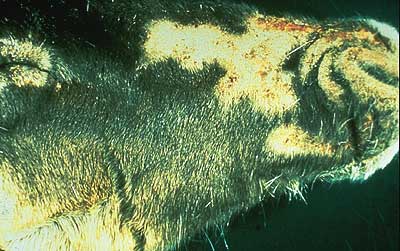Parasites and Diseases
Besnoitiosis
A Field Guide
TO COMMON WILDLIFE DISEASES
AND PARASITES IN ALASKA
BESNOITIOSIS (Bone Meal Disease)

Hair loss and roughened skin on caribou muzzle. Sometimes called “sand paper caribou.”
| What causes besnoitiosis? |
- Besnoitiosis is caused by an intracellular parasite (Besnoitia tarandi).
- Lifecycle: The parasite needs both an herbivore (e.g., caribou or muskox) and a carnivore host. The parasite multiplies in the herbivore forming cysts that contain many spores. The carnivore becomes infected when it eats meat from a herbivore with cysts. The parasite comes out in the carnivore’s droppings and contaminates plants that are eaten by herbivores.
| Where does besnoitiosis occur? |
- Besnoitia may be able to infect a wide range of ungulates (hoofed animals).
- It occurs in caribou, reindeer, and muskoxen.
- In Alaska, besnoitiosis occurs commonly in caribou.
| What are the signs of besnoitiosis? |
- Animals usually appear healthy.
- Heavily infected animals may lose hair on their lower legs and face, and skin may be thick.
- Besnoitiosis can be most easily identified when skinning the lower legs.
- Cysts are hard and feel like a slight roughness (“sand paper”) over the bone and skin.
- Cysts appear as clear to white very small round lumps (like grains of corn meal) embedded in tissue.
- Similar tiny cysts may be visible on the eye.
| How can I protect myself? |
- You cannot get besnoitiosis from infected animals.
| Can I eat the meat? |
- Meat from infected animals is suitable for human consumption.
- Cook meat well.
- Do not feed infected meat to dogs.
| Samples to collect |
- Lower front leg or affected tissues.
- To report an occurrence or to submit a sample for identification/analysis, contact the DWC Wildlife Disease Surveillance reporting hotline 907-328-8354, send an email to dfg.dwc.vet@alaska.gov or visit your local ADF&G office.
